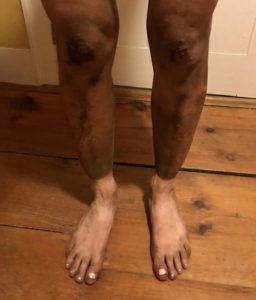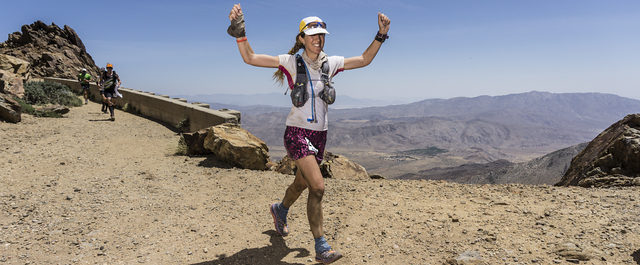
The toughest part of an ultra can still be ahead
What is the toughest part of an ultra? Is it the 4 a.m. alarm? Is it the dark, chilly start? Is it the long, lonely middle miles, when niggles are nagging, but long before it’s a good idea to indulge in finish line fantasies? Is it the last push on tired legs, when every pebble on the trail seems like a huge boulder and every gentle incline like the back side of Hope Pass?
None of these things come close to what we face after the race is over, and I don’t mean the physical aches and pains. The mental process of re-adjusting to life in the outside world can be worse.
While I run, while I pace, even while I take care of hallucinating, hypothermic 100-milers at an aid station all night long, I feel at home: I’m among people who understand me, people who need no explanation about why, or how, anyone would run that far. This comfort zone is like a bubble around the race course. It more than makes up for any physical suffering I might experience. But it’s a rude awakening once I leave the bubble, once I face, usually on Monday morning, what we euphemistically call “real life.” A recurring problem, and surely not mine alone
The re-entry process is tough because it means adjusting to a vastly different outlook on life. My old and very wise anthropology professor used to define culture as “rules for the proper.” I think of his lectures a lot when traveling to and from trail races. He taught us that all over the world, norms and standards about everything and anything — table manners, kinship, clothing, appropriate conversation topics — draw the lines between “us” and “other people who aren’t like us.” The culture of ultra running has standards that set it apart from mainstream culture in several key aspects. Here are a few helpful tips I designed for fellow runners who face the difficult transition from one to the other:

Post-race, pre-shower.
1. Cleanliness
Mainstream US culture is obsessed with it. Germs are the enemy, cans of Lysol are everywhere, and a daily shower, complete with soap and shampoo (twice!) is considered normal.
Many parts of the world have a somewhat more relaxed view of the matter. Ultra culture has a much more relaxed view. You shower when you can. When you can’t, a wet rag or baby wipes will do just fine. Picking twigs and leaves out of your hair is all the styling you need. Washing your hands before eating? Nah, a waste of water. Picking food off the ground, dusting it off, and eating it? Of course — better than wasting it. When you return to the office environment on Monday morning, remember that these rules have changed. Clothes without stains from blood,, sweat, or other bodily fluids are considered dirty just because you’ve worn them once or twice. Picking food off the floor, or twigs out of your hair, is frowned upon. It’s not recommended to go for a lunchtime run, return with no time to spare, and attend an afternoon meeting without showering first, just so you get that extra mile in. Trust me on this — I’m speaking from experience.

Helpful information at Western States
2. Bodily functions
Among ultra runners, a loud burp will earn you compliments, and complete strangers discuss the color of their pee compared to the color of their post-race beer. A fart is a sign that food is moving in the right direction, and well-launched snot rockets are a source of entertainment as well as personal pride. It’s important to keep in mind that mainstream culture diverges sharply from ultra culture in this regard. We are expected to maintain a thick wall of silence and embarrassment around these subjects. Though every human pees, poops, burps, farts, spits, and snots, these parts of our existence are not appropriate conversation topics in most settings. Also, remember that standards of privacy during potty breaks increase dramatically in more urban surroundings. A tree in a city park or in someone’s front yard is not a port-a-shrub. Using it as such might get you arrested in some places, even in drought-stricken areas.

The climb up Hope Pass reduces my speech to grunting sounds every time
3.Communication
Ultra runners are, by and large, honest people. Of course, there are exceptions. When working an aid station, it’s perfectly fine to tell a runner how fresh and energetic she looks at mile 80, even as you help her to the nearest chair where she collapses in a heap of blisters and tears. This is not a moment for brutal openness. A slight deviation from the naked truth is more helpful. But in most other situations, we say what we mean and mean what we say, without much added fluff. Even once pain and exhaustion reduce our speech to grunting sounds, we generally understand each other (for additional information about the discourse conventions of ultra running, click here: http://runkat.com/wordpress/?p=138). We rarely gossip, not because we’re saints, but because we don’t have the mental energy to weave intrigues. Our ultra brain won’t remember who said what about whom a few miles ago, or a few races ago, so why bother? Keep in mind that, in the real world, grunting is considered rude. Communication is much more verbal, and much less straightforward. Be aware that what people say should hardly ever be taken at face value, e.g. the phrase “We need to have lunch sometime.” translates as ” We probably never will have lunch together, though I may find you slightly less revolting than some of my other co-workers.” Also be aware of something called small talk — i.e. utterly meaningless pieces of conversation about bland, general topics. Though you may not see the point of it — because there isn’t one — try to become familiar with at least the basic level. Otherwise, you might face social ostracism.
4. Priorities

Climbing Wheeler Peak should be on everyone’s to-do list.
Ultras are simple: you put one foot in front of the other. You keep doing that for 5 to 35 hours, or until you cross the finish line, whichever comes first. You roll with the rhythm of the trail, the time of day, and the weather conditions. You slow down in the dark, the heat, up the hills. You enjoy the beauty of a sunrise, a sunset, maybe another sunrise, and everything in between. You drink when you’re thirsty. You eat whatever looks appealing. After you’re done, you rest and refuel. Mainstream culture is, again, much more complicated: there are many rules about what to do when, and how, and with whom: work, exercise, socialize. To-do lists require checkmarks, inboxes require attention, schedules are crammed with activities. I am not sure why, but items like “Play in dirt all day” or “Climb tall mountain — enjoy view” don’t commonly appear on to-do lists, or on schedules. There are other sets of rules about what to wear, e.g. running clothes and shoes should only be worn for running, even when they’re the most comfortable clothes you own. Try to follow the example of your co-workers. When in doubt, ask a family member, or a non-running friend. And don’t forget to register for another ultra as soon as your DOMS has subsided. Then count the days until your next race, when you can forget about all these nonsensical rules for a long weekend. Good luck!

.



Hey those are my kind of people!! I also have re-entry issues after a horse show like that!
Oh, true — another parallel between the universes!
Yep, nailed it. I am suffering mightily this week following Cactus to Cloud. I keep telling myself, “Do not blow a snot rocket in the hallway!!”
I’m so glad I’m not alone. Invigilated an exam this morning and had to spend three hours looking like a serious-minded professional. Ugh.
Great writing because it is so the truth!
Thanks for reading, Mike. I really feel much better now that I know other people share this strange and unpleasant experience.
Hey,
I’m not an ultrarunner, but I’m married to one. She said that this rang true for her. She sent it to me to read. I thought it read well.
Since I do some writing, it occurred to me that this was the sort of thing runners’ magazines thrive on. I think you should consider checking on the submission guidelines for Ultrarunner or Trail Runner then submitting it for publication.
Good luck.
Mary Ann Stout
Hey Mary Ann,
thanks for the vote of confidence. I would love to see my writing published, but have no idea how to go about this. I’ll check out my running magazines — where would I find submission guidelines? Are there any other helpful tips you’d be willing to share with a newbie writer?
Katrin
Katrin,
Each publication has its own submission guidelines. For Trail Runner go to http://www.trailrunnermag.com and look under contributors. For Ultra Running I found the guidelines on page 6 of the April number under Submissions.
Both of these magazines seem to welcome unsolicited material and tell you how they like to get it.
I imagine there are other places that take unsolicited submissions, but these two are one’s Gail (Leedy) my spouse has around the house. I’d start with these. If the guidelines are unclear, email them and ask.
Let me know what you decide to do.
Mary Ann